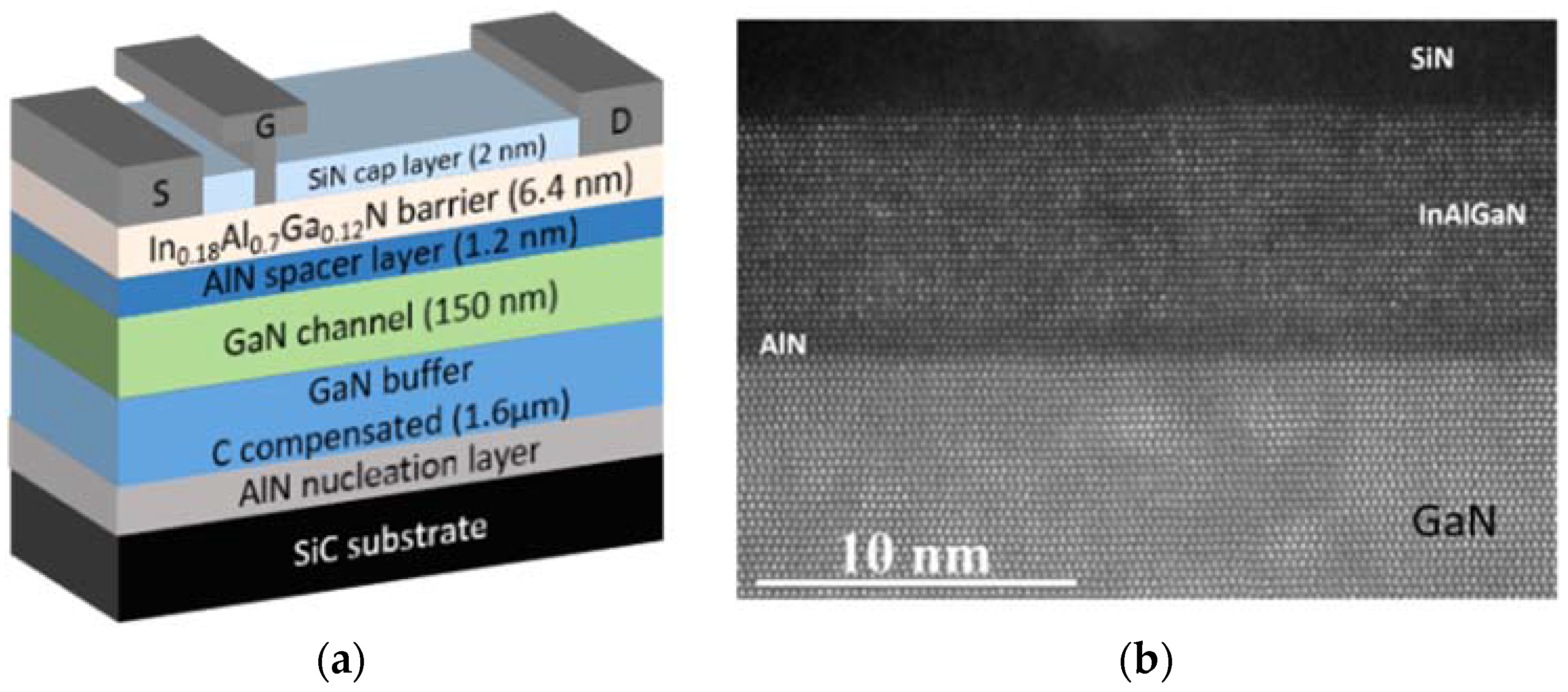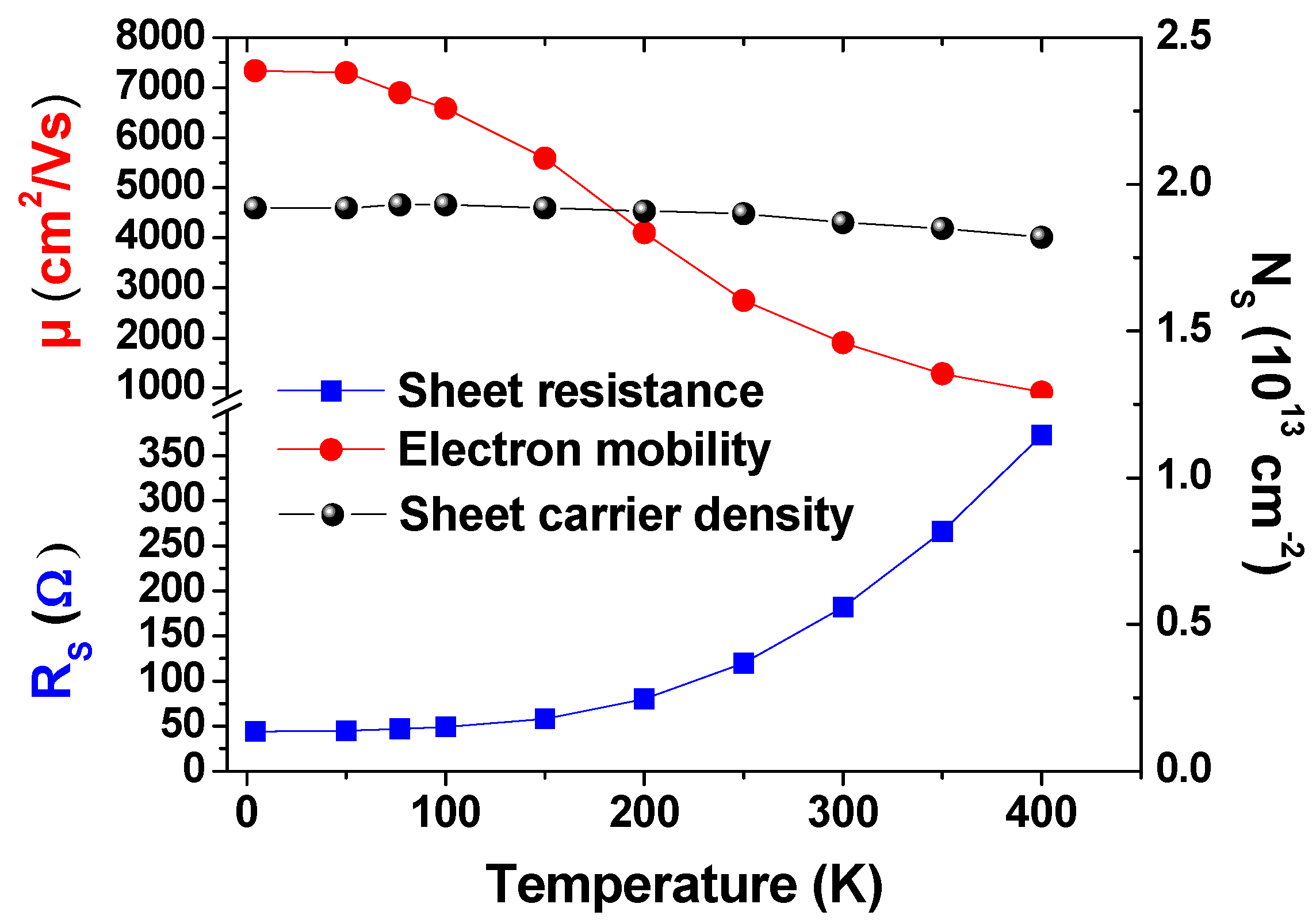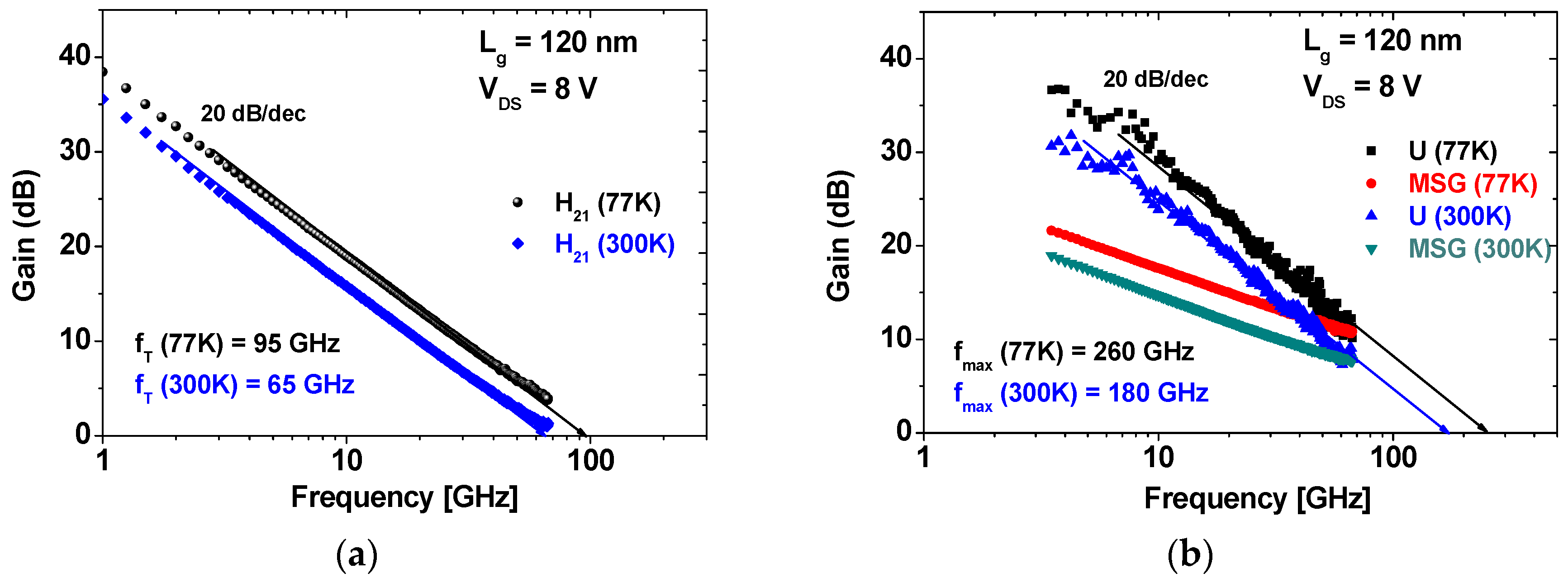InAlGaN/GaN HEMTs at Cryogenic Temperatures
Abstract
:1. Introduction
2. Device Fabrication
3. Results
DC and RF Characteristics at RT and 77K
4. Conclusions
Acknowledgments
Author Contributions
Conflicts of Interest
References
- Kuzmik, J. Power electronics on InAlN/(In)GaN: Prospect for a record performance. IEEE Electron Device Lett. 2001, 22, 510. [Google Scholar] [CrossRef]
- Kohn, E.; Medjdoub, F. InAlN—A new barrier material for GaN-based HEMTs. In Proceedings of the International Workshop on Physics of Semiconductor Devices, 2007, Mumbai, India, 16–20 December 2007; pp. 311–316.
- Gonschorek, M.; Carlin, J.F.; Feltin, E.; Py, M.A.; Grandjean, N. High electron mobility lattice-matched AlInN/GaN field-effect transistor heterostructures. Appl. Phys. Lett. 2006, 89, 062106. [Google Scholar] [CrossRef]
- Liu, Y.; Egawa, T.; Jiang, H. Enhancement-mode quaternary AlInGaN/GaN HEMT with non-recessed-gate on sapphire substrate. IEEE Electron Device Lett. 2006, 42, 884–886. [Google Scholar] [CrossRef]
- Makiyama, K.; Ozaki, S.; Ohki, T.; Okamoto, N.; Minoura, Y.; Niida, Y.; Kamada, Y.; Joshin, K.; Watanabe, K.; Miyamoto, Y. Collapse-free high power InAlGaN/GaN-HEMT with 3 W/mm at 96 GHz. In Proceedings of the 2015 IEEE International Electron Devices Meeting (IEDM), Washington, DC, USA, 7–9 December 2015; pp. 9.1.1–9.1.4.
- Gao, X.; Pan, M.; Gorka, D.; Oliver, M.; Schuette, M.; Ketterson, A.; Saunier, P. Ultra-thin barrier quaternary InAlGaN HEMTs with state of the art sheet resistance. Phys. Status Solidi C 2014, 11, 495–497. [Google Scholar] [CrossRef]
- Hwang, J.H.; Kim, S.; Woo, J.M.; Hong, S.; Jang, J.-H. GaN HEMTs with quaternary In0.05Al0.75Ga0.2N Schottky barrier layer. Phys. Status Solidi C 2016, 213, 889–892. [Google Scholar] [CrossRef]
- Ketteniss, N.; Khoshroo, L.R.; Eickelkamp, M.; Heuken, M.; Kalisch, H.; Jansen, R.H.; Vescan, A. Study on quaternary AlInGaN/GaN HFETs grown on sapphire substrates. Semicond. Sci. Technol. 2010, 25, 055012. [Google Scholar] [CrossRef]
- Wang, R.; Li, G.; Verma, J.; Sensale-Rodriguez, B.; Fang, T.; Guo, J.; Hu, Z.; Laboutin, O.; Cao, Y.; Johnson, W.; et al. 220-GHz Quaternary Barrier InAlGaN/AlN/GaN HEMTs. IEEE Electron Device Lett. 2011, 32, 1215–1217. [Google Scholar] [CrossRef]
- Lim, T.; Aidam, R.; Waltereit, P.; Henkel, T.; Quay, R.; Lozar, R.; Maier, T.; Kirste, L.; Ambacher, O. GaN-based submicrometer HEMTs with lattice-matched InAlGaN barrier grown by MBE. IEEE Electron Device Lett. 2010, 31, 671–673. [Google Scholar] [CrossRef]
- Medjdoub, F.; Kabouche, R.; Linge, A.; Grimbert, B.; Zegaoui, M.; Gamarra, P.; Lacam, C.; Tordjman, M.; Forte-Poisson, M.F. High electron mobility in high-polarization sub-10 nm barrier thickness InAlGaN/GaN heterostructure. Appl. Phys. Express 2015, 8, 101001. [Google Scholar] [CrossRef]
- Tulek, R.; Iygaz, A.; Gokden, S.; Teke, A.; Ozturk, M.K.; Kasap, M. Comparison of the transport properties of high quality AlGaN/AlN/GaN and AlInN/AlN/GaN two-dimensional electron gas heterostructures. J. Appl. Phys. 2009, 105, 13706. [Google Scholar] [CrossRef] [Green Version]
- Wu, Y.F.; Kapolnek, D.; Ibbetson, J.P.; Parikh, P.; Keller, B.P.; Mishra, U.K. Very-High Power Density AlGaN/GaN HEMTs. IEEE Trans. Electron. Devices 2001, 48, 586–590. [Google Scholar]
- Endoh, A.; Watanabe, I.; Yamashita1, Y.; Mimura, T.; Matsui, T. Effect of temperature on cryogenic characteristics of AlGaN/GaN MIS-HEMTS. Phys. Status Solidi C 2009, 6, S964–S967. [Google Scholar] [CrossRef]
- Sensale-Rodriguez, B.; Guo, J.; Wang, R.; Verma, J.; Li, G.; Fang, T.; Beam, E.; Ketterson, A.; Schuette, M.; Saunier, P.; et al. Time delay analysis in high speed gate-recessed E-mode InAlN HEMTs. Solid-State Electron. 2013, 80, 67–71. [Google Scholar] [CrossRef]
- Xue-Feng, Z.; Li, W.; Jie, L.; Lai, W.; Jian, X. Electrical characteristics of AlInN/GaN HEMTs under cryogenic operation. Chin. Phys. B 2013, 22, 017202. [Google Scholar]




| Substrate | Electron Mobility (cm2·V−1·s−1) | Sheet Carrier Density (cm−2) | Sheet Resistance (Ω/□) |
|---|---|---|---|
| Sapphire | 1060 | 1.74 × 1013 | 340 |
| SiC | 1800 | 1.93 × 1013 | 191 |
© 2016 by the authors; licensee MDPI, Basel, Switzerland. This article is an open access article distributed under the terms and conditions of the Creative Commons Attribution (CC-BY) license (http://creativecommons.org/licenses/by/4.0/).
Share and Cite
Dogmus, E.; Kabouche, R.; Lepilliet, S.; Linge, A.; Zegaoui, M.; Ben-Ammar, H.; Chauvat, M.-P.; Ruterana, P.; Gamarra, P.; Lacam, C.; et al. InAlGaN/GaN HEMTs at Cryogenic Temperatures. Electronics 2016, 5, 31. https://doi.org/10.3390/electronics5020031
Dogmus E, Kabouche R, Lepilliet S, Linge A, Zegaoui M, Ben-Ammar H, Chauvat M-P, Ruterana P, Gamarra P, Lacam C, et al. InAlGaN/GaN HEMTs at Cryogenic Temperatures. Electronics. 2016; 5(2):31. https://doi.org/10.3390/electronics5020031
Chicago/Turabian StyleDogmus, Ezgi, Riad Kabouche, Sylvie Lepilliet, Astrid Linge, Malek Zegaoui, Hichem Ben-Ammar, Marie-Pierre Chauvat, Pierre Ruterana, Piero Gamarra, Cédric Lacam, and et al. 2016. "InAlGaN/GaN HEMTs at Cryogenic Temperatures" Electronics 5, no. 2: 31. https://doi.org/10.3390/electronics5020031






